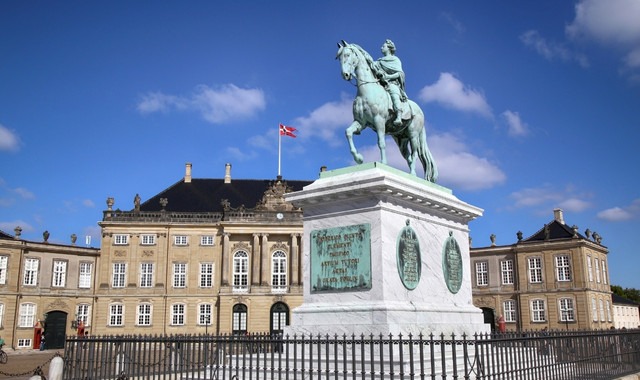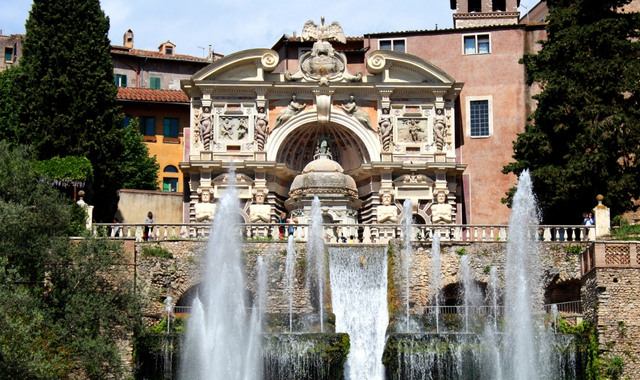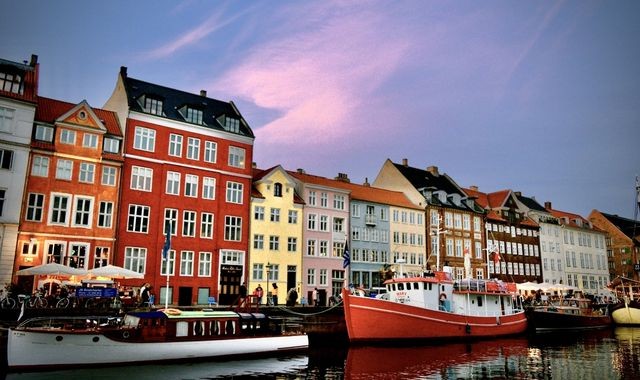Copenhagen
Hovedstaden, DenmarkCopenhagen is the capital and largest city of Denmark, known for its charming atmosphere and rich history. The city is located on the eastern coast of the island of Zealand and is surrounded by canals and waterways. On Ferryhopper, you can find useful information about must-see places, local delicacies, and ferries to Copenhagen and book your tickets easily and quickly!

The impressive Amalienborg Palace in Copenhagen
Vacation in Copenhagen
Copenhagen is a charming and vibrant city offering a unique blend of history, culture, and modernity. If you’re wondering what makes it so special, then keep reading! Did you know that Copenhagen is one of the most environmentally friendly cities in the world with a strong commitment to sustainable living?
It is no coincidence that there are so many bikes around the city. It is actually known for its bike-friendly streets and it is certainly one of the best ways to explore the center.
So, take your bike and enjoy a ride parallel to the canals while taking a glance at its sightseeing such as the iconic Black Diamond library and the Royal Opera House.
Except for its cutting-edge architecture, Copenhagen also is rich in history and culture with many museums, historical sites, and palaces such as the Amalienborg Palace to confirm it. Whether you go shopping on Strøget street or go for a drink in the neighborhoods of Vesterbro and Nørrebro, the city of Copenhagen enchants you immediately.
How to get to Copenhagen
You can travel to Copenhagen by plane, bus, train, car or ferry. Copenhagen is well-connected with domestic and international flights. The main airport serving the city is the Copenhagen Airport, which is located just 8 km from the city center. From there, you can take the metro, train or bus to reach the beautiful capital of Denmark.
It is also possible to arrive in Copenhagen by bus or train as the city is well connected to the European transportation network. You can easily reach the city thanks to several rides available from Sweden or Germany. There are also direct trains to Copenhagen from Hamburg (4 hours 40 minutes) and from Stockholm (5 hours 30 minutes).
Copenhagen is also accessible by ferry with several ferry crossings operating from nearby countries such as Germany, Sweden and Norway. Therefore, if you’re planning to travel by ferry you can find more information about ferry routes and schedules to Copenhagen below.
What to do in Copenhagen
Copenhagen is a vibrant city with many beautiful corners and picturesque little squares. Having 4-5 days ahead is enough time to experience many of its highlights. You start with a stroll around the city center to see the main sights of Copenhagen.
Wave back to Hans Christian Andersen’s Little Mermaid sitting on the rocks, the imposing bronze statue by Edvard Eriksen, marvel at the Amalienborg Palace, and enjoy the stunning views from the Round Tower.
Then, you can take a walk along the picturesque Nyhavn district to enjoy a waffle or a traditional Danish lunch by the sea. However, Nyhavn is the most instagrammable and touristic area of Copenhagen so it’s better to grab a coffee and go early in the morning to enjoy a walk parallel to the colorful houses there.
During your stay in the capital of Denmark, you can also visit the Tivoli Gardens in the sunset and stay a little longer to see how beautifully are illuminated at night. You can also go shopping in the beautiful neighborhood of Strøget, where you can find several cute shops and boutiques.
Tip: if you’re planning to stay for a week, you can also take a day trip to nearby towns such as Malmö, Sweden or Roskilde.

Impressive fountains in Tivoli Gardens
Sightseeing in Copenhagen
Copenhagen is a city filled with many interesting sights and landmarks that are worth visiting. Here are some of the most popular attractions for sightseeing in Copenhagen:
- The Little Mermaid statue, one of the most famous landmarks in Copenhagen
- The Amalienborg Palace, the residence of the Danish royal family
- The Round Tower (Rundetaarn), an imposing tower with a stunning view
- The Rosenborg Castle, an iconic Renaissance castle built in the early 17th century
- The National Museum of Denmark, with exhibitions about Denmark’s history and culture
- The National Gallery of Denmark, home to a large collection of Danish and international art, including works by famous Danish artists such as C.W Eckersberg and Christen Købke
- The Tivoli Gardens, an amusement park featuring rides, verdant gardens, and a concert hall
- The Church of Our Saviour, an impressive Baroque church famous for its spiral staircase
- The Nyhavn district, a colorful 17th-century waterfront with charming houses

The Little Mermaid's bronze statue in Copenhagen
Nightlife in Copenhagen
Copenhagen is known for its vibrant nightlife, with a wide range of options for those looking to have a drink or dance. The city center is home to many bars and clubs, including the Meatpacking District, which is known for its trendy bars and clubs.
You can also head to Vesterbro, a neighborhood known for its bars and nightclubs, or to Nørrebro, which is popular for its alternative and multicultural scene. For a more traditional experience, you can visit a Danish pub and enjoy a beer.
Tip: during your stay, you can also check the Royal Danish Theater and the Tivoli Concert Hall for theater performances and live music concerts.
Food in Copenhagen
Copenhagen is known for its delicious traditional cuisine, which is heavily influenced by its location on the coast and its long history of fishing. Here are five traditional finger-licking dishes that visitors should try when in Copenhagen:
- smørrebrød (a sandwich made with dense, dark rye bread filled with meat, fish, or cheese)
- frikadeller (meatballs, made with pork and veal)
- stegt flæsk med persillesovs (crispy pork belly with parsley sauce and boiled potatoes)
- rødgrød med fløde (a dessert made of red berries, sugar, cornstarch, and whipped cream)
- wienerbrød (a buttery pastry dough filled with almond paste)
Tip: get across the bridge of Inderhavnsbroen for the best street food. In this food court located in Strandgade, you will find the most delicious local delicacies. Make sure to accompany your meal with local beer from a microbrewery like Mikkeller.

The traditional Danish sandwich with meat and fish
Tips
Here are 4 tips for your stay in Copenhagen:
- Purchase a City Pass, which gives you unlimited access to buses, trains, and metro lines, as well as discounts on many attractions. It’s a great way to get around the city, and it’s also affordable.
- Denmark is considered one of the most cashless societies in the world, thus many places you’ll find contactless payment terminals, including public transportation and small stores.
- Don’t miss taking a canal tour: there are several canal tour companies that offer tours of the city’s canals.
- Visit Christiania, a self-proclaimed autonomous neighborhood in Copenhagen that is known for its alternative lifestyle and counterculture.
- If you are looking for a place to store your luggage because you have some extra time before catching a flight or a ferry back home, you can find lots of souvenir shops in the central street of Copenhagen, Strøget in which you can leave your luggage for a small fee. There are also a few mobile applications available so you can download them to find all the available souvenir shops at a close distance.
Useful information about Copenhagen
Copenhagen is a modern and well-equipped city, offering a wide range of services to visitors. The city has a reliable public transportation system, with buses, trains and metro lines connecting different areas and the airport. You can also find a wide range of shops and supermarkets for all their needs, as well as many post offices, banks and ATMs.
As for accommodation, Copenhagen offers a variety of accommodation options to suit different budgets and preferences. You can choose between luxury hotels, boutique hotels, and budget-friendly hostels. The city also offers a range of camping and caravan options if you’re into a more outdoorsy experience.
Related to hospitals, Copenhagen has a well-developed healthcare system. You can easily find emergency care at the city’s major hospitals, such as Rigshospitalet and Herlev Hospital, which are equipped to handle a wide range of medical conditions.
Also, the city has several private clinics, as well as a number of 24-hour pharmacies. However, keep in mind that you should probably pay for healthcare services upfront, so it is advisable to have your travel insurance and a valid form of identification with you.
Important phone numbers for your stay in Copenhagen
Here are some useful contacts for your trip to Copenhagen:
- Copenhagen Port Authority: +4533746000
- Copenhagen Police Department: +45114
- Copenhagen Public Transport Network: +4571272930
- Copenhagen Hospital: +4570203040
- Copenhagen Airport: +4532313231
- Tourist Information: +4533151415
- Medical assistance: +4570113131
- European emergency number: 112
Transportation in Copenhagen
Copenhagen is a very bike-friendly city, and biking is one of the best ways to get around the city. There are many bike rental shops around the city. However, keep in mind that most rental shops will require you to leave a deposit and an ID.
The public transportation system in Copenhagen is also very efficient and reliable. The metro, bus, and train networks are operated by the same company, known as "Movia". You can purchase a single ticket or a multi-day pass at the station. Alternatively, you can use the "Rejsekort" which is a contactless smart card that can be used on all forms of public transport.
Walking is also a great option for getting around the city center, as many of the main sights are within walking distance of each other.
Tip: if you’re thinking of renting a car, you should keep in mind that leaving your vehicle in a parking lot can be quite expensive.
Ports in Copenhagen
Copenhagen has several ports that serve as entry points for visitors arriving by ferry. The 2 main ports are the Freeport Terminal and the Oceankaj Terminal. The Freeport Terminal is in the southern part of the city and is the main terminal for cruise ships visiting the city.
It is also a hub for ferries traveling to and from Germany, Sweden, and Norway. The Oceankaj Terminal, on the other hand, is located in the northern part of the city and is mainly used for freight and cargo ships.
The passenger terminal is located at the Freeport Terminal and it is equipped with all the necessary facilities for travelers, including information desks, restrooms, and a waiting area. The terminal is also close to public transportation, making it easy for visitors to get to the city center.
Both ports of Copenhagen are located a bit away from the city center, but they are well-connected to the city center by public transportation such as metro, bus, and train. You can easily arrive and take the metro, or the regional train to the city center in just a few minutes.

The picturesque district of Nyhavn in Copenhagen
Copenhagen ferry: schedules and tickets
The port of Copenhagen can be reached by ferry from Finland (Mariehamn, Åland), Germany, Sweden, and Norway.
You can take ferries from these countries to the city’s main passenger terminal located at the Freeport Terminal. The main companies that operate these ferry connections are Scandlines, Stena Line and DFDS.
Here you can find more information on the ferry connections to Copenhagen:
- Hamburg-Copenhagen ferry: the connection between Hamburg and Copenhagen is operated by Scandlines with several daily crossings all year round. The crossing takes about 3 hours.
- Malmö-Copenhagen ferry: there are several daily ferry connections between Malmö and Copenhagen and the journey lasts around 40 minutes.
- Oslo-Copenhagen ferry: the Oslo - Copenhagen ferries are operated by DFDS with several daily crossings all year round. The ferry trip takes about 17 hours.
- Travemünde-Copenhagen ferry: the ferry from Travemünde to Copenhagen is operated by Scandlines with several daily crossings all year round. The crossing takes about 4 hours.
- Gothenburg-Copenhagen ferry: the ferry between Gothenburg and Copenhagen is operated by Stena Line with several daily crossings all year round. The journey takes about 5 hours.
Book ferry tickets to Copenhagen online
On Ferryhopper, you can find all available ferry routes to and from Copenhagen on our Map of ferries, compare prices, and departure times, and book cheap ferry tickets to Copenhagen online at no extra cost.
Copenhagen ferry schedule
View the complete ferry schedule from and to Copenhagen for the upcoming week. Find up-to-date trip information, including departure and arrival dates and times, ferry operators and ticket prices.